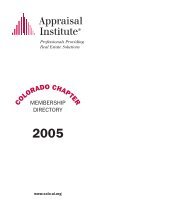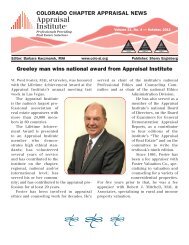June2005 - Colorado Appraisal Institute
June2005 - Colorado Appraisal Institute
June2005 - Colorado Appraisal Institute
You also want an ePaper? Increase the reach of your titles
YUMPU automatically turns print PDFs into web optimized ePapers that Google loves.
Recently, I completed an appraisal that involved a<br />
leasehold interest of a hangar that was on land owned<br />
by a governmental entity. In performing this appraisal,<br />
I obtained information on possessory interest valuation<br />
that appeared to be quite inequitable to leasehold<br />
interests. This article applies only to commercial uses,<br />
not ski areas or agricultural leases.<br />
As we all are aware, taxpayers who hold leases on<br />
various government owned parcels now are required<br />
to pay property taxes on the possessory interests as<br />
required by 39-1-103 (17) (a) (II), CRS. This statute<br />
requires that possessory interests in real estate and<br />
personal property, other than land permitted for use as<br />
ski area recreational land, must be valued considering<br />
the Cost, Market, and Income Approaches to value.<br />
When using the Cost Approach or Income Approach to<br />
value, the statutes direct that the present value of the<br />
reasonably estimated future annual rents or fees, less<br />
statutory exclusions, paid by the possessory interest<br />
holder to the government over the initial term of the<br />
lease be determined. The course materials for <strong>Appraisal</strong><br />
516 of the CATA 2004 Course states that the “procedures<br />
employ a ‘modified’ Net Present Value (NPV) calculation<br />
technique” for the valuation of commercial<br />
and agricultural possessory interests. Modification was<br />
necessary to include an effective tax rate as a component<br />
of the NPV conversion rate.<br />
For the purpose of the procedures, NPV is defined as:<br />
“A value determined by discounting all future benefits,<br />
either in the form of a lump sum or a series of periodic<br />
installments such as rent or a combination of both,<br />
based on the assumption that benefits received in the<br />
future are worth less than the same benefits received<br />
today.”<br />
This information goes on to state that the following<br />
data is needed to do the NPV calculation.<br />
• Actual Rental Rate in the Agreement (if actual rent is<br />
indicative of market rents)<br />
• Current Market Rental Rates (if actual rent is not<br />
indicative of market rents)<br />
• Duration of the Agreement (for agreements that have<br />
a duration of one year or less it is assumed to be for<br />
one year)<br />
• Contractual Rent Adjustments and Their Expected<br />
Rates of Change<br />
• Costs and Exclusions Documented in the Agreement<br />
• Discount Rate as of the Assessment Date<br />
•Effective Tax Rate as of the Assessment Date<br />
• Appropriate Compound Interest Table<br />
For all appraisers who have had to calculate present<br />
values on leased fee estates, it can be noted that the<br />
one item missing from the above “necessary data” is a<br />
future value, or reversionary interest. In fact, in the<br />
valuation of possessory interests, this is not an item of<br />
concern. After some other explanations in the course<br />
materials, it is stated that, for the development of the<br />
discount rate for possessory interests, two items are<br />
Page 10<br />
POSSESSORY INTERESTS<br />
Jack Nisley, MAI<br />
necessary. The first is a standard discount rate, with<br />
the sources stated being local lending institutions or<br />
other sources such as the Real Estate Investments<br />
Survey for the Rocky Mountain Region published by<br />
Smith/Burbach. These sources are used to support the<br />
rate developed locally. Next, the effective tax rate is<br />
developed using the mill levy as a decimal multiplied<br />
by the assessment rate as a decimal. This equals the<br />
effective tax rate, which is then added to the discount<br />
rate to establish the Net Present Value Conversion<br />
Rate. The course material states that the assessor may<br />
round up the Net Present Value Conversion Rate to the<br />
next highest half percent in order to use published<br />
tables for the present worth of one or the present worth<br />
of one per period to determine the appropriate conversion<br />
factor. This present worth of one factor is then<br />
applied to each year remaining in the initial term of the<br />
lease. The calculations can be done on a financial calculator,<br />
as a formula used in a computer spreadsheet<br />
program, or by present worth tables. If the agreement<br />
indicates that the payment will be identical for each<br />
year, use of a present worth of one per period factor<br />
based on the conversion rate and remaining years may<br />
be used in place of the present worth of one—dollar<br />
factor.<br />
After this occurs, the present value of the possessory<br />
interest is adjusted to actual value by the use of the<br />
“level of value adjustment factor”. This adjustment factor<br />
is estimated using the same procedures and principles<br />
as provided for in Section 39-1-104 (12.3) (a) (I),<br />
CRS. This procedure basically takes into consideration<br />
the fact that the first year of the reappraisal cycle (an<br />
odd numbered year) is the base year from which the<br />
adjustment for the second year is taken. For real property,<br />
the factor is based on median changes to the<br />
Western District averages for real property construction<br />
costs between the June 30 th appraisal date and the<br />
January 1 st assessment date as report in Section 98,<br />
Page 7 of the Marshall and Swift Valuation Manual published<br />
by the Marshall Valuation Service. The course<br />
materials state that the present value of the payments<br />
is what is calculated. This does not take into consideration<br />
any reversionary interests.<br />
After the above data is used in a discounted cash<br />
flow analysis, the Net Present Value indication is then<br />
multiplied by the assessed value ratio (29%) for an<br />
assessed value, with the assessed value multiplied by<br />
the mill levy for the possessory interest tax amount.<br />
The point of all of this is that if, as in many airports,<br />
hangar leases or ground leases for improvements may<br />
go on a 20-year lease term at the same time as another<br />
lease of a similar property goes under a 10-year lease<br />
term, tax consequences can be extremely different. As<br />
an example, we can assume three leases occur on<br />
identical properties at levels of 5-years, 10-years, and<br />
20-years, on an annual basis, with the income stream<br />
on each of the properties at $14,400.00. If we use a Net<br />
Present Value Conversion Rate including the effective<br />
tax rate at 12%, the Net Present Value of the income





